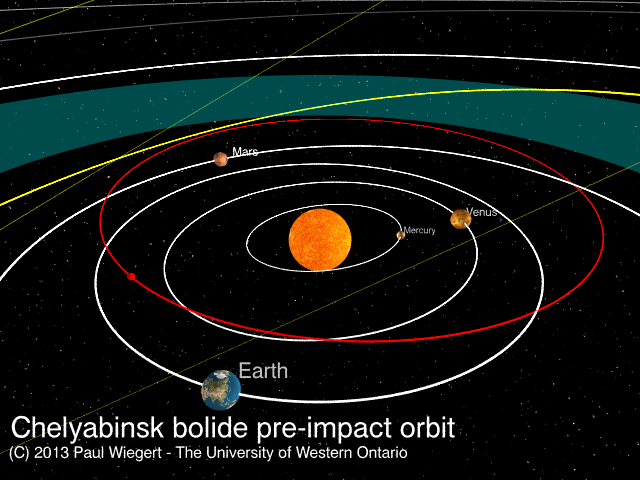TORONTO – Dramatic asteroid events like the one that caused an airburst over Chelyabinsk, Russia, last February are more common than previously thought.

A group of Western University researchers, part of an international team, has concluded that events like the Chelyabinsk meteor occur once every 30 or 40 years – not 120 to 150 years, as previous models predicted.
The Chelyabinsk meteor was roughly 19 metres in diameter, and weighed an estimated 12,000 tons. The meteor, pushing air in front of it, created an airburst that knocked people to the ground, shattering windows and damaging buildings.
Read more: Meteorite that exploded over Russia 4.4 billion years old, new study confirms
Researchers from Western University’s Centre for Planetary Science and Exploration (CPSX) collected data on the Chelyabinsk meteorite that helped them determine the chances of an asteroid of similar size and energy exploding and affecting Earth.
“Over the last 20 years…we’ve been using U.S. government sensors and infrasound sensors that listen to shockwaves from very big airbursts, very big meteors,” Peter Brown, Professor of Physics and Astronomy at Western University told Global News. Brown, along with Margaret Campbell-Brown, Paul Wiegert and David Clark were part of the research team.
The team used that data and compared it to telescopic impact data, where these asteroids are actually seen.
“When we compare them with the telescopic impact frequency, we seem to be seeing more things hitting the Earth in the tens of meters size range than what the telescopic data suggests.”
But don’t worry: Because Earth is mostly water, chances are slim these airbursts will happen over land and even slimmer over densely populated areas.
Canadian meteors
Canada is no stranger to meteors and meteorites. (Meteors are pieces of space debris that burn up in Earth’s atmosphere; meteorites are meteors that reach the ground.)
In January 2000, a large meteorite exploded over British Columbia. The debris fell onto Tagish Lake, which, fortunately for researchers, was frozen. The meteor was estimated to be 200 metric tons, five metres in diameter, resulting in an explosion equivalent to two to three kilotons of TNT. For comparison, the Chelyabinsk meteorite exploded with a force of 600 kilotons.
In 2008 a meteorite broke apart over Buzzard Coulee, Saskatchewan and, in 2009, one exploded over Grimsby, Ont.
One of the benefits of this finding may be future missions to scan the skies to give more warning time for people in order to avoid injuries like those that occurred in Chelyabinsk.
The research was published in the scientific journal Nature.




Comments